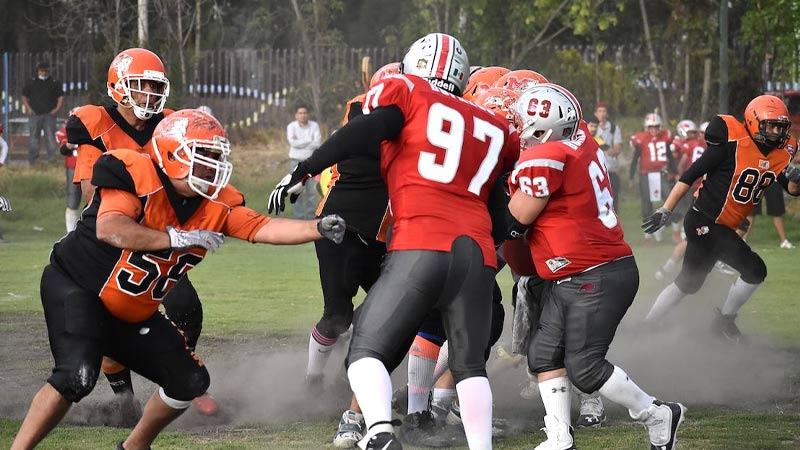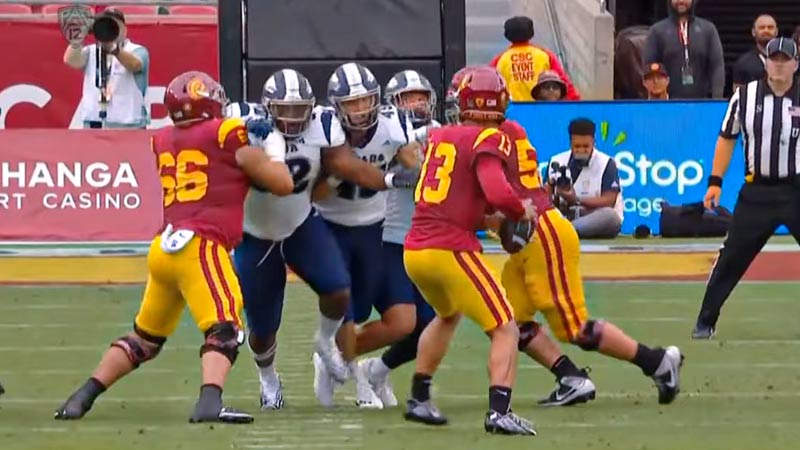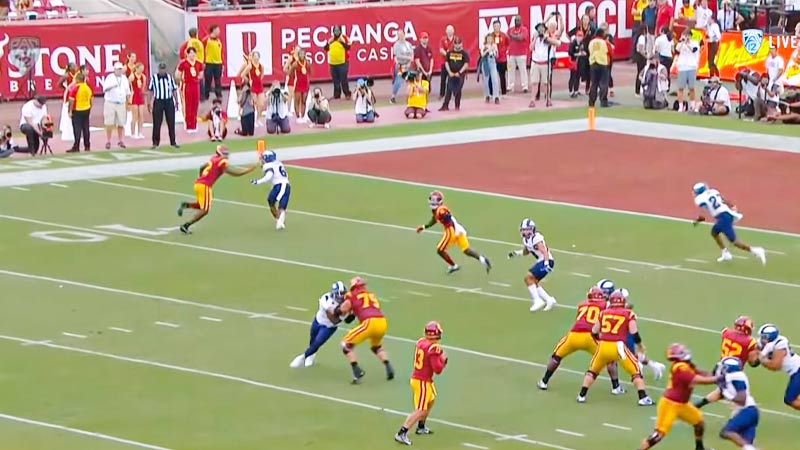In the dynamic world of American football, coaches and defensive coordinators are constantly seeking new strategies to thwart their opponents’ offensive onslaughts.
Amidst the ever-evolving array of defensive formations, the 6-2 defense stands as a classic, time-tested approach that emphasizes stopping the run and pressuring the quarterback.
In this blog post, we delve into the intricacies of the 6-2 defense, exploring its components, advantages, disadvantages, and its relevance in modern football.
Whether you are a seasoned football enthusiast or a curious newcomer to the sport, let’s unlock the secrets of the 6-2 defense together.
What Is Football 6-2 Defense?
The 6-2 defense in American football is a defensive formation that features six defensive linemen and two linebackers. It is considered an older and more traditional defensive alignment that was commonly used in the past. In recent times, it has become less prevalent as football strategies and offensive schemes have evolved.
The main objective of the 6-2 defense is to stop the opponent’s running game by employing a large number of linemen at the line of scrimmage. The six-down linemen create a strong presence upfront, making it difficult for the offense to establish a successful rushing attack.
This defense is particularly effective against teams that heavily rely on running plays and have a weaker passing game.
The two linebackers in the 6-2 defense are responsible for providing additional support in stopping the run, covering short to medium passes, and helping in pursuit if the play stretches out to the edges.
Components of 6-2 Defense

The 6-2 defense in American football consists of six defensive linemen and two linebackers. Each component plays a specific role in the overall defensive scheme. Let’s delve into the components of the 6-2 defense:
Defensive Linemen (DL)
Nose Tackle (NT): The nose tackle lines up directly over the center and is responsible for occupying multiple offensive linemen to create space for the linebackers to make plays. The NT must be strong, tough, and able to shed blocks effectively.
Defensive Tackles (DT): The two defensive tackles line up on either side of the nose tackle, typically between the guards and tackles. They are tasked with clogging the interior gaps, disrupting running plays, and putting pressure on the quarterback on passing plays.
Defensive Ends (DE): The two defensive ends align outside the offensive tackles. They are responsible for containing outside runs, rushing the passer, and setting the edge to prevent the ball carrier from turning upfield.
Linebackers (LB)
Inside Linebackers (ILB): The two inside linebackers are positioned behind the defensive linemen. They play a critical role in stopping the run, filling gaps, and making tackles. They need to be strong, instinctive, and capable of reading the offense’s movements to react quickly to plays.
Defensive Backs
The 6-2 defense typically employs five defensive backs, but this may vary based on the specific defensive play called or the game situation. The defensive backs are responsible for covering the offensive receivers and providing additional pass-defense support.
The 6-2 defense aims to create a dominant presence in the trenches with six down linemen to disrupt the opponent’s running game and put pressure on the quarterback.
The two inside linebackers provide additional support against the run and can drop back into coverage against passing plays.
The success of the 6-2 defense relies on the ability of the defensive linemen to control the line of scrimmage, the inside linebackers’ tackling and coverage skills, and the cooperation and communication of the entire defense to execute the game plan effectively.
Practice the Strategies of 6-2 Defense

Practicing the strategies of a 6-2 defense requires a systematic approach that involves both individual player drills and team-oriented exercises. Here’s a step-by-step guide on how to practice the strategies of the 6-2 defense effectively:
Understanding the Defensive Scheme
Before starting any practice, ensure that all players, especially the defensive linemen, and linebackers, understand the 6-2 defense scheme thoroughly. Review the roles and responsibilities of each position to ensure everyone is on the same page.
Individual Drills
Conduct individual drills for each defensive position to develop specific skills. For defensive linemen, practice techniques like hand placement, shedding blocks, and gap control.
For linebackers, work on tackling, reading offensive keys, and pass coverage skills.
Linemen Gap Control
Set up drills that focus on the defensive linemen’s gap assignments. Use cones or markers to represent gaps, and have the linemen practice filling these gaps to stop imaginary running plays. Emphasize discipline and staying in position.
Linebacker Read-and-React Drills
Design drills that help linebackers read the offensive formations, identify run plays, and react quickly. Use running backs or offensive players as ball carriers in these drills to simulate real-game scenarios.
Run-Fit Drills
Incorporate team-based run-fit drills to ensure all players understand their roles in stopping various running plays. Work on gap integrity, pursuit angles, and maintaining proper spacing within the defense.
Pass Coverage Exercises
Practice pass coverage scenarios for linebackers and defensive backs. Work on zone and man-to-man coverages, emphasizing communication and proper positioning in coverage.
Defensive Line Stunts
Implement defensive line stunts and twists to generate pressure on the quarterback. Focus on timing and coordination between the linemen to create disruption in the backfield.
Team Scrimmages
Organize full-team scrimmages to implement the 6-2 defense in live game situations. Allow the defense to face different offensive formations and adjust their alignments accordingly.
Film Study
Review game film from previous matches to identify areas of improvement in executing the 6-2 defense. Analyze individual and team performances to pinpoint strengths and weaknesses.
Communication and Cohesion
Emphasize the importance of communication and teamwork within the defense. Practice on-field communication to ensure everyone is aware of their assignments and can adjust to any offensive changes.
Conditioning
The 6-2 defense can require significant physical demands, especially from the defensive linemen. Incorporate conditioning drills to improve stamina and endurance to maintain a high level of play throughout the game.
Coaching and Feedback
Provide constructive feedback and coaching to individual players based on their performance during practice. Encourage players to ask questions and seek clarification to improve their understanding of the defensive scheme.
By following this structured practice plan, your team can effectively develop and implement the strategies of the 6-2 defense.
Regular and focused practice will lead to better execution on the field, making the defense a formidable force against the opponent’s offensive strategies.
Advantages of 6-2 Defense

The 6-2 defense in American football offers several advantages that can make it a valuable defensive strategy, especially against teams that heavily rely on the running game. Some of the advantages of the 6-2 defense include:
Strong Run Defense
With six down linemen, the 6-2 defense creates a formidable wall at the line of scrimmage. The abundance of defensive linemen makes it difficult for the offense to establish a running game.
This defense is especially effective in short-yardage situations and near the goal line, where stopping the run is crucial.
Gap Control
The 6-2 defense allows for excellent gap control against the run. Each defensive lineman and linebacker is responsible for specific gaps, making it challenging for running backs to find holes to exploit. The defense can maintain discipline and limit big gains on the ground.
Pressure on the Quarterback
With six defensive linemen, the 6-2 defense can generate significant pressure on the quarterback without relying heavily on blitzing. This can disrupt the quarterback’s timing, force hurried throws, and result in sacks or turnovers.
Stopping Off-Tackle Runs
The defensive ends in the 6-2 alignment are well-positioned to defend against off-tackle runs, which are plays that attack the edges of the defensive line.
By setting the edge, the defense can force the ball carrier back inside, where the interior linemen and linebackers are waiting.
Limited Passing Windows
The presence of six linemen and two linebackers can create tight passing windows for the opposing quarterback.
This makes it more challenging for the offense to complete short and intermediate passes, as the defense can clog up the middle of the field.
Goal-Line Defense
The 6-2 defense is particularly effective in goal-line situations due to its ability to stuff the run and prevent the offense from gaining a yard or two in critical scoring situations.
Disguise and Confusion
The 6-2 defense can present a unique look to opposing offenses, especially if they are not accustomed to facing this alignment. This can create confusion and force offenses to adjust their game plan on the fly.
Versatility and Adaptability
While the 6-2 defense is primarily geared toward stopping the run, it can be adjusted to defend against passing plays by using different coverage schemes and blitz packages. This versatility allows the defense to adapt to different offensive strategies.
While the 6-2 defense has its advantages, no defensive formation is perfect, and its effectiveness can vary depending on the opponent’s strengths and weaknesses.
Modern football defenses often use a combination of different alignments and strategies to counter diverse offensive approaches. Nonetheless, the 6-2 defense remains a valuable option for teams looking to build a strong run-stopping unit and apply pressure on the quarterback.
Disadvantages of 6-2 Defense

The 6-2 defense, like any defensive strategy, also has its share of disadvantages and limitations. Here are four subheadings outlining some of the main drawbacks of the 6-2 defense:
Vulnerability to the Pass
Limited Coverage: With only two linebackers and five defensive backs, the 6-2 defense may struggle to cover all areas of the field effectively.
This can leave passing lanes open, making the defense vulnerable to short, intermediate, and deep passing plays.
Play-Action and Misdirection: The emphasis on stopping the run in the 6-2 defense can make it susceptible to play-action and misdirection plays.
Overcommitting to stop the run may leave the defense exposed to big passing plays downfield.
Susceptible to Spread Offenses
Spreading the Defense Thin: The 6-2 defense may struggle against spread offenses that spread the field with multiple wide receivers and exploit the open spaces created by the limited number of defenders in coverage.
Spread formations can force the defense to cover more ground and increase the risk of missed assignments.
Quick Passing Game: The 6-2 defense can be challenged by quick-passing offenses that use short, quick throws to neutralize the pass rush and keep the defensive linemen from getting to the quarterback.
Inflexibility Against Strong Passing Teams
Difficulty in Adjustments: Due to its emphasis on stopping the run, the 6-2 defense may have difficulty adjusting to strong passing teams or late-game situations that require a quick shift to a pass-heavy approach.
The lack of coverage personnel can hinder the defense’s ability to respond effectively.
Personnel Limitations
Finding Ideal Players: Successfully executing the 6-2 defense requires specific personnel with the size, strength, and agility to play along the defensive line and carry out their assignments effectively.
Teams lacking the right personnel may struggle to implement the 6-2 defense optimally.
Fatigue: The 6-2 defense can place significant physical demands on the defensive linemen, as they often need to handle multiple blockers and engage in constant battles at the line of scrimmage.
This can lead to fatigue over the course of a game, potentially reducing the defense’s effectiveness in late-game situations.
While the 6-2 defense offers strengths against the run and can generate pressure on the quarterback, its vulnerabilities to the pass, spread offenses, and strong passing teams, as well as its personnel limitations, make it a less versatile option compared to other defensive formations.
Successful implementation of the 6-2 defense depends on understanding and addressing these disadvantages while strategically using it to capitalize on the opponent’s weaknesses.
FAQs
What is the 6-2 defense in football?
The 6-2 defense is a defensive alignment featuring six down linemen and two linebackers. It aims to create a dominant presence upfront to stifle the opponent’s running game while also generating pressure on the quarterback.
How does the 6-2 defense work against the run?
The 6-2 defense relies on a large number of defensive linemen to control the line of scrimmage and occupy blockers, allowing the two linebackers to fill gaps and make tackles against the run. It is particularly effective in short-yardage situations and near the goal line.
What are the advantages of using the 6-2 defense?
The 6-2 defense offers strong run defense, excellent gap control, and pressure on the quarterback, and is especially effective in goal-line situations. It can also create confusion for opposing offenses due to its unique look.
What are the weaknesses of the 6-2 defense?
The 6-2 defense can be vulnerable to the pass, struggle against spread offenses, and have difficulty adjusting to strong passing teams or late-game situations. Finding the right personnel can also be a challenge.
How can teams practice and implement the 6-2 defense effectively?
Practicing the 6-2 defense requires a systematic approach, including individual drills for linemen and linebackers, run-fit and pass coverage exercises, and regular scrimmages. It is essential to emphasize communication, teamwork, and adaptability during practice.
Wrapping Up
The 6-2 defense remains a compelling strategy in American football, boasting strengths in stopping the run and pressuring the quarterback. While it has its drawbacks and limitations, teams that understand the nuances of this classic formation can utilize it to their advantage.
As football tactics and strategies continue to evolve, the 6-2 defense serves as a testament to the sport’s rich history and the enduring principles that make it an essential part of the game’s legacy.
So, whether you’re a coach looking to strengthen your defensive unit or a fan seeking to deepen your understanding of the game, exploring the depths of the 6-2 defense is a journey well worth taking.







